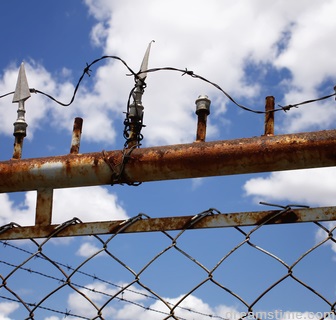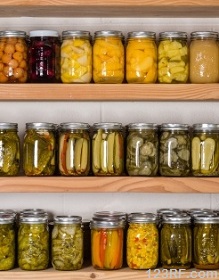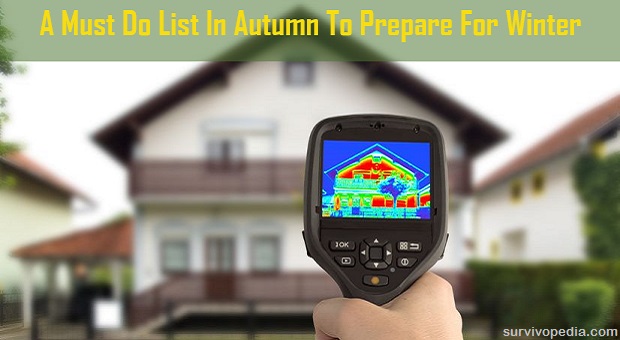As the sunny, care free days of summer comes to an end, cooler fall days remind us of all the little things that have to be done before winter arrives. In times of crisis, taking care of these matters will be more important than ever because you may not be able to buy parts for things that break due to lack of appropriate maintenance, or obtain help with repairs in a timely fashion.
It should also be noted this is not an inclusive list since weatherization and other needs may vary from one region to another.
If you aren’t sure about what things are most needed in your intended bug out area, at least make it a point to research, and then formulate a complete list of prepping needs for this fall season.
Prepare Your Heating Systems
Regardless of the fuel source, going over every inch of your main and backup heating systems is very important. If you currently use oil or some other processed fuel to heat your home, you may want to start thinking about the following systems for your post-crisis homestead needs.
Individuals that choose to integrate some of these systems now may be able to save money on power bills and enjoy increased independence at the same time.
Fireplaces and Wood Stoves
Different kinds of wood leave differing amounts of soot and creosote deposits in the chimney. These substances must be removed regularly or there is a chance of a chimney fire.
Cleaning fireplaces and wood stoves is a very dirty job that can only be started when ashes, and every other part of the system is cold. It is advisable to wear old clothes and rubber cloves to protect yourself from the soot and creosote. It is also a good idea to protect the floors, furniture, and the carpet.
When inspecting fireplaces and wood stoves, make sure the flues are in good working order. If not, this is the time to repair them. Check to see if there are any visible cracks in the chimney that might let smoke escape before exiting all the way at the top. Any loose or broken chimney bricks or stones should be replaced and resealed to strengthen the chimney’s integrity.
When all the cleaning, inspections, and repairs are completed the fireplaces and the wood stoves should be safe to use and give plenty of good heat for the winter.
Clean and Inspect Solar Heating and Hot Water Systems
Start by cleaning all of the solar panels to remove all the dirt, bugs, and grime that has built up over the summer and fall.
Check all pumps for leaks, stuck valves, and heat pump water systems. Take steps to prevent scaling (usually caused by hard water), corrosion, or freezing. Check the water softening systems to insure the water will be scale free.
Also check the water pumping system for corrosion that might lead to system failure due to cracking pipes or sticking valves.
If you live in an area that in winter the temperatures fall below 32 degrees, there is a definite chance that the water in the pipes will freeze and bust pipes or valves in the water systems.
Check the antifreeze in the water if it is used to keep the system from freezing and top off if necessary. If antifreeze is not used to protect these systems, you will have to drain down the water until antifreeze can be obtained.
Sometimes it is cheaper to turn off or remove the solar system during the winter months and rely on more conventional systems instead. At least you will not be stuck with huge repair bills on top of a system that fails when you need it most.
Inspect and Clean All Windmills Used for Pumping Water and Producing Electricity
To ensure that the windmills work correctly the fan bearings and stabilizer bearings must be grease packed to keep them from freezing up. Check the fan blades for any breaks, dents, or tears which could cause the fan to be unbalanced and damage the windmill. If the windmill is pumping water, check all water pipes for leaks, cracking, or loss of suction.
For wind mills used to produce electricity, check all wiring, the generator, and all other electrical parts for proper function.
Survivor Decision Point: Having a Portable Backup Source of Heat
If you are in a crisis situation, oil, kerosene, and wood may not be available. While you may still be able obtain enough paper for burnable bricks, it is also important to look for low scale, cheap heating sources. In this instance, making your own candle heaters from clay pots may be the best option.
If you make a few tealight candle heaters, or have them on hand, clean and inspect them before you use them. During the winter months you will also need to dry the pots out and remove soot on a weekly basis in order to ensure the most heat radiation. These procedures insure that the heater is safe to use and will not cause any unwanted fires.
Disassemble the tealight heaters to the basic component parts checking all three flower pots for chips, cracks, or holes. The nuts, bolts, and washers need to be cleaned or replaced if broken. When finished reassemble and the tealight heaters will be ready for use when needed.
Perimeter Defenses

If you rarely do defensive drills, make sure to do at least a few in the fall season. Do emergency defensive drills to keep the group well practiced, make sure everyone knows their jobs, and work on cross training to do other jobs when the need arises. Do not let the group get stuck in a rut or get lazy. If this happens it could cost the group everything it has built or accomplished.
Check all fields of fire to ensure the whole complex is covered by at least two over lapping fields of fire. Firearms training and practice is a must. When shooting always know your target and know what is behind the target.
Storing Ice and Snow for the Spring and Summer Ice House
Since most of ice houses are made of brick or stone, check for broken or missing bricks or stones and replace them. If you are thinking about expanding the ice house this is the time to do it. Clean out the old straw or other packing materials from the ice pit.
When the ice pit is clean, check the stone bottom and sides to ensure a good strong foundation to put the ice on. This is also the time for checking to be sure you have enough straw for this winters ice house use.
Check the water level of the lake or pond that you will be using to cut the ice blocks from. Are these bodies of water high or low? If the water level is low or very low, it is advisable to look and line up other sources of water that could be used to supplement usable water for ice.
Check, clean, and sharpen all of the ice cutting tools so they will be ready to use when the time comes. If any are broken try to fix or replace before the ice cutting season begins.
Food Storage and Harvesting for Winter and Spring Food Supplies
As the fall crops are harvested there should be a general awareness of what is going on around outside of the homestead. Are there any new strangers in the area? If so how many, are they planning to stay, or move on? With the group’s food supply being harvested there is a greater chance of outsiders attempting to steal it for their own use.
Remember if the harvest is stolen the odds are that your group will not survive the winter.
Hunting Game and Fishing for Winter and Spring Food Supplies
Fall is also an excellent time to go over your ammo stores, clean and lubricate weapons, and make sure everything works properly. This is especially important if you don’t do routine weapon maintenance throughout the year and plan to hunt enough game to last until the spring.
For the hunting of deer, bear, and other large game animals, a bow or a crossbow would be the weapon of choice because there is less noise. If you do have to use a rifle or a shotgun, use the one shot one kill philosophy. Using more than one shot makes it easy for others to figure out your location, and then steal what game you killed or even follow you back to the homestead.
If this group is a raiding party they will wait to strike until they have the advantage. When this time comes the group will have to fight and kill to keep their food and property.
If the homestead is near rivers, lakes, or the ocean, fishing would be another good food source. The fish could be smoked, dried, frozen (weather permitting), or eaten fresh. This is a good time for checking and servicing all of the fishing gear and nets.
Any good size pond on the property could be turned into a live fish holding area with a little work. All that is needed is to transport the live fish from other rivers or lakes and put them in your pond. To help feed the fish set out minnow traps to catch the minnows to feed the pond fish.
Canning Vegetables and Meat for the Winter

If any of the canning seals are broken or the lids are bulging, discard the contents of these jars at once because bad food can make people sick or even kill then. After all of the old can goods have been checked and rotated, make sure that you know why any spoilage occurred and try to avoid that mistake during the new harvest.
After the new canning season is complete, put dates on the new can goods before shelving, and then update the food supply record to indicate how many cans are available and what is in them. The food supply record is also an ideal place to note spoilages so that you can see if any patterns emerge.
Indoor Planting for Food
There are three ways to grow plants indoors: planted in pots, hydroponics, and aquaponics.
Those plants that are planted in pots must have a good light source, be re-potted at least twice a year, and fertilized regularly. Failure to do this will cause the plants to die or not to produce vegetables.
Hydroponics is the growing of plants using a nutrient solution in water without soil. The roots must have a time period when the roots are misted, then allowed to dry a little. Do not let the roots stay wet or there is the possibility of root rot.
Drying time also helps cut down on algae in the root area. You can also wrap dark paper or plastic around the root growing area in the growing trays to reduce algae that require light. Check the lighting and the temperature in the hydroponics growing area to give the best growing conditions possible.
Aquaponics is the combination of fish farming and soil-less growing of plants. With this symbiosis the fish in tank eat and make poo that that is pumped up to the growing beds to be broken down to a usable fertilizer. The cleaned water is then returned to fish tank. Not only does the farmer get plenty of good healthy vegetables, but plenty of fish to eat.
In order to maintain a healthy aquaponics system: always monitor pH, ammonia, and hardness levels or the fish will die. You should also keep in mind the temperature and lighting needs for both fish and plants.
As the days get shorter and your to-do list gets longer, it is time to get the homestead ready for winter. It is a great feeling to see all of those items on the list completed before winter starts and knowing that all who live on the homestead will be safe and sound during this time of the year.
This article has been written by Fred Tyrell for Survivopedia.










Pingback:A Must Do List In Autumn To Prepare For Winter | Survivalist Basics | Be Prepared For Anything! | October 26, 2014
|
Pingback:A Must Do List In Autumn To Prepare For Winter | TheSurvivalPlaceBlog | November 1, 2014
|
Pingback:Winter Survival: How To Snow Shovel Like A Pro | Survivopedia | January 28, 2016
|
Pingback:Winter Survival: How To Snow Shovel Like A Pro | Prepper's Survival Homestead | January 28, 2016
|
Pingback:Winter Survival: How To Snow Shovel Like A Pro | NewZSentinel | January 31, 2016
|
Pingback:Winter Survival: How To Snow Shovel Like A Pro | TheSurvivalPlaceBlog | February 1, 2016
|
Pingback:Winter Survival And Blizzard Prep Tips | Survivopedia | March 6, 2018
|